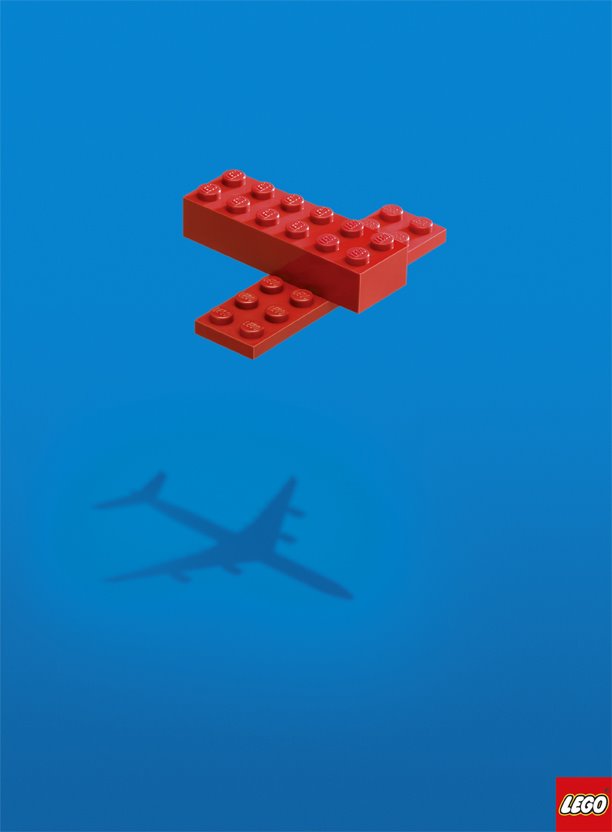The key statement being made is that LEGO bricks provide the mechanism to build anything and do anything that your imagination entails. The company evokes feelings of endless fun and creation without any words or gimmicks, but with just two of their most famous bricks.
By using a minimalist approach, the iconic LEGOs are clearly the primary focus of the image. By having a suggestive airplane shadow being “reflected” off from the creation, the relationship between the two items indicates that the LEGO bricks and the airplane figure are not two separate things.
Rather, the LEGO figure is the airplane itself, casting a shadow of what it is meant to be. The use of a shadow to represent this relationship is meaningful as shadows often represent the image of the beholder. As Alice Yoo states, the paring of the shadow with the LEGO figure expresses our own ability to use our imagination to make the LEGO creations come to life.
The ad implies that by using our imagination, something small like LEGO bricks can reflect something large and powerful like an airplane. Yet, without the bricks themselves, the shadow (and our potential for imagination) disappears. Therefore, the symbolism of the shadow figure not only calls upon the consumer to have the creative potential to turn those bricks into something meaningful, but presents the bricks as tools needed for imaginative production.
Using only two primary colors (red and blue), the warmer red color of the LEGO bricks strongly stands apart from the cool blue background. Here, blue also functions to further reinforce the idea that the bricks are an airplane, as it is a color most often reminiscent of blue skies.
Paired with the three dimensional structure and orientation of the LEGOs, the figure seems to come to life, ready to soar off the page. Thus successfully showcasing how your imagination can make LEGOs take flight.
Cleverly, the specific blue and red hues displayed in the image are the same classic colors used in their LEGO bricks. This reinforces familiarity and is a subtle connection back to their product. The color cues allows the consumer to quickly associate the message of unlimited creation and imagination to the one and only LEGO brand.
Further, while LEGO bricks are typically seen as children’s toys, the solitariness of the product (in contrast to having children play with it) removes this bias from the product. In a revolutionary change of events, LEGO seems to be turning away from the toy stigma, and moving towards the idea that LEGOs are agents for creativity. Establishing that LEGOs aren’t just for playing, they’re for creating. So why is this distinction important?

The LEGO Group is a privately owned toy company with deep roots in the business of toys. In fact the brand name LEGO, is an abbreviation of “leg godt,” Danish for play well. Yet as Jake Mckee, previous leader on the LEGO company community board explains, there was a time when most of the company’s product production was done without any insight to their consumer base.
LEGO had closed its doors to any outside input for fear of lawsuits. Which meant that they no longer knew who their customers were. When they discovered online chat groups created by adults who built with LEGOs, they uncovered the potential in expanding towards a larger audience. One that included these adults who would spend large sums to produce large scale LEGO creations.
Lindsay Kolowich writes in her blog, Building a Playful Brand, Brick by Brick: The History of Lego Marketing, that this 2006 print ad was released as part of the company’s new movement to recreate the brands image. This ad symbolizes what Mckee noted, LEGO is no longer just a toy for children; it is now a creative medium.
By focusing on the creative potential of LEGOs, the ad associates a concrete object like LEGO bricks, with the concept of boundless creation. Thus, by using their iconic bricks as the centerfold of the page, LEGO reminds us that being creative doesn’t have to be left behind like most other childhood mementos. Rather, with an assemblage LEGO bricks by your side, your creativity and imagination can just keep on building.

No comments:
Post a Comment